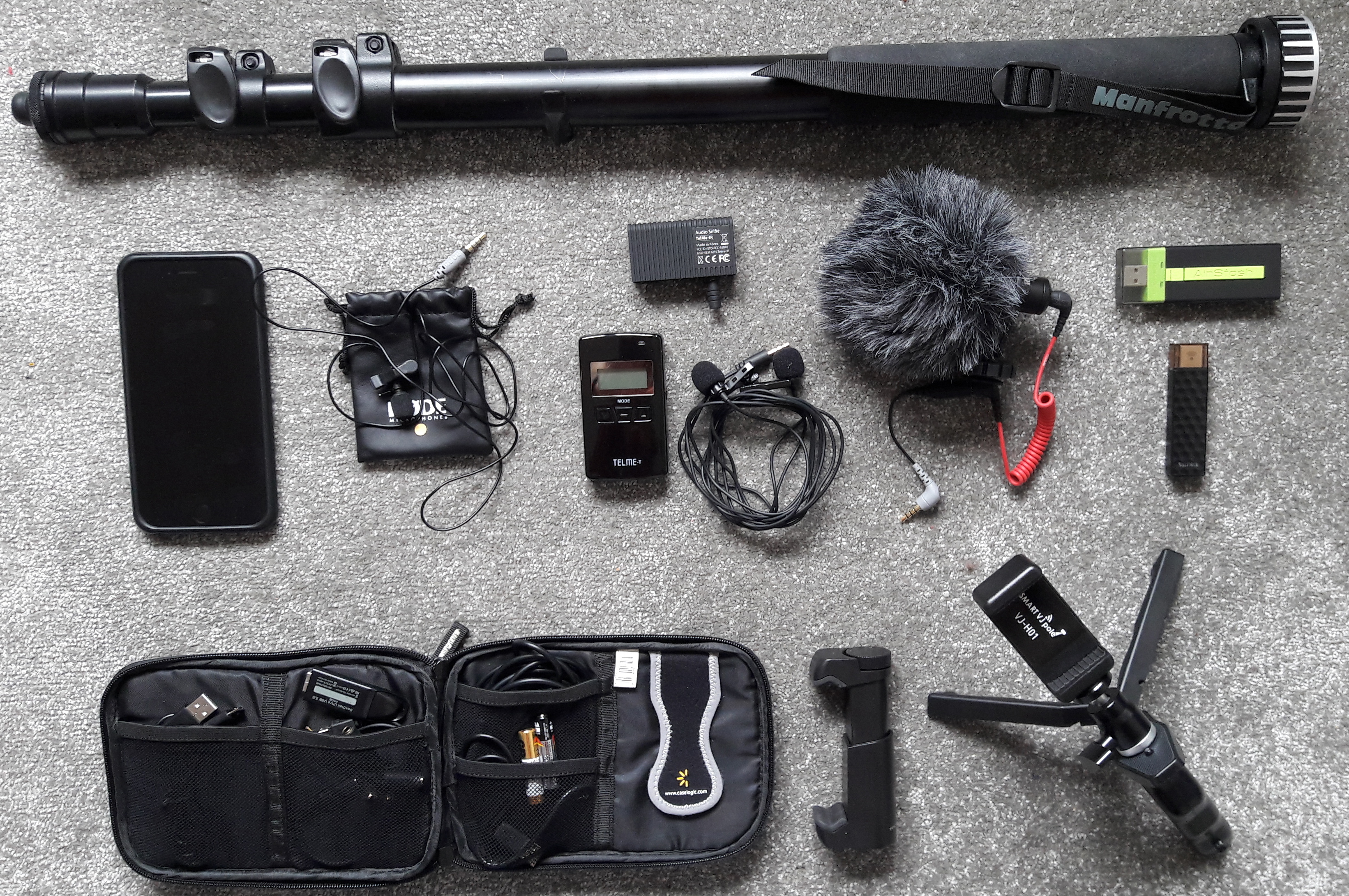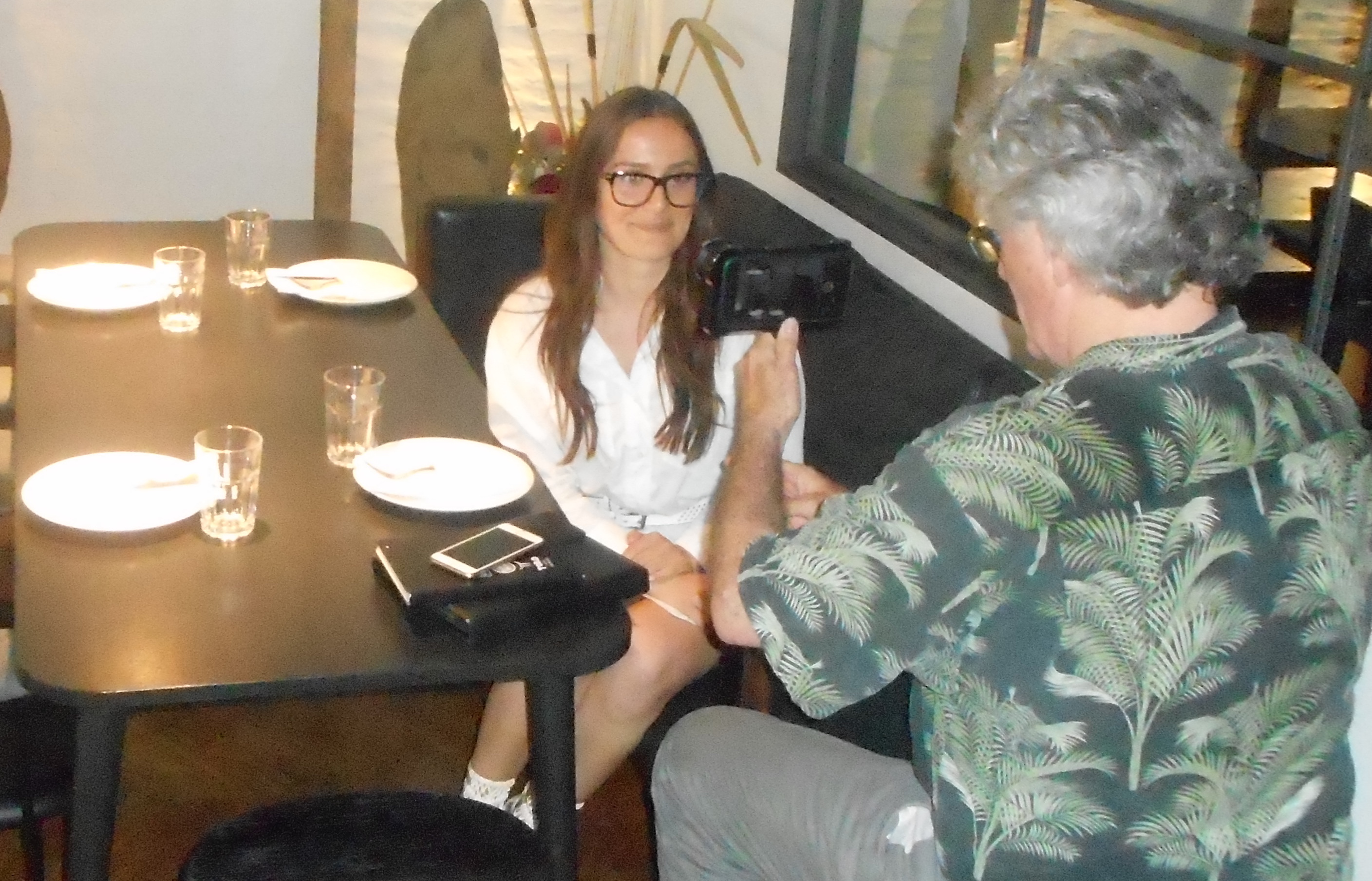In recent years Stephen Quinn has trained journalists, citizens and students in 20 countries to make high-quality videos with only an iOS device and some inexpensive apps. Most courses are repeated. His current focus is using AI tools for making fiction films. This page updated 13 March 2024.
Clients have included China Daily in Hong Kong, the Philippines Daily Inquirer, The Age (Australia), the Foreign Press Association in London, Birmingham City University’s post-graduate journalism program (UK), Coventry University’s journalism course (UK), Pearl Academy (India), G.D. Goenka University (India), the Leon, Spain, campus of Washington University (USA), Beijing Foreign Studies University and Kristiania University (Norway).
Email Stephen Quinn if you would like to talk about mojo training: sraquinn (at) gmail (dot) com. Examples of Dr Quinn’s mojo work can be found at his YouTube site. Dr Quinn uses only an iPhone, a good microphone and a handful of apps.
The photos below show one of Dr Quinn’s mojo kits from 2020. It consists of a Manfrotto monopod (top of photo), with a collapsable tripod built into the base. The second row shows (from left) an iPhone, a Rode SmartLav+ lapel microphone, a Rode Go wireless mic, a Rode VideoMicro shotgun mic with deadcat, and two wireless storage devices: an AirStash (16Gb but you can insert an SD card up to 64Gb) and a SanDisk Connect Stick (128Gb).
The third row shows (from left) a CaseLogic case for holding bits and pieces. Items in the case include spare batteries, an extension cable for the Rode microphone, and a Rode SC6 plug for connecting headphones so I can monitor sound quality when doing interviews. Next to that is a Shoulderpod grip for connecting my iPhone to a tripod, and at bottom right a SmartGun tripod mount. Not shown: a recharge device for the iPhone.

A good site for buying mojo equipment is the ReporterStore.
It is possible to be a mojo with a simple kit consisting of an iPhone, a microphone with a wind sock and a file storage device (SanDisk Connect Stick) for backup. The total cost is about £800. See the “essential mojo kit” photograph below.
Some recommendations
“Stephen Quinn teaches how to teach mojo-journalism. In 60 minutes he gave me material for a 6-day course 🙂 Chapeau!” Kris Crooner, via Twitter, 8 June 2019.
“Just wanted to convey our network’s sincere gratitude for your kind gesture and hope to witness more of your impressive performance in the future.” Hamed Naderian, news editor at PressTV in Tehran, Iran, August 2018.
“Stephen delivered a superb workshop, informative, useful and engaging. There was just the right balance of essential information and instruction without overloading students, delivered alongside plenty of practice to cement learning and make it fun for students – who were by the end of the day making some impressive first attempts at mobile video journalism. The perfect kick off to their own learning and exploration. In addition, Stephen is well versed not just in the latest equipment but also in terms of current industry trends and there was extra value in being able to have some discussion on these points, such as insights into the new Facebook ‘Watch’ platform. We’d love to have you back nest year!” Sharron Lovell, director, MA in Multi-Media Journalism, Beijing Foreign Studies University, October 2017.
“I have invited Stephen Quinn to deliver a special mobile journalism masterclass for the past three years at Birmingham City University. Dr Quinn is an acknowledged global expert in this field and the skills covered in his classes are important to a range of fields. Students from a range of disciplines including MA and BA courses in journalism, television production and radio were all invited to attend. Students who attended overwhelmingly commented on the transformatory and inspirational nature of the experience, with many choosing to continue working in the field afterwards. I would recommend Stephen highly.” Paul Bradshaw, Course leader, MA Multiplatform and Mobile Journalism, Birmingham City University, by email, November 2017.
“Professor Stephen Quinn presented a MOJO training course to my University of Washington (Seattle) journalism and political communications students on October 10, 2017 at the UW Study Center in León, Spain. http://depts.washington.edu/leonctr/ Dr. Quinn’s talk was inspirational, informational and practical. He illustrated the extraordinary power of the iPhone as tool of visual story-telling, but made learning how to use the tool easy and fun for the students. After Dr. Quinn’s presentation I gave my students a video assignment using their phones and his instructions, and they all produced surprisingly high-quality work. Our students found Dr. Quinn’s presentation style engaging and eloquent. We would be happy to have him return to give more classes any time.” Katie King, University of Washington, León, Spain.
“I would like to ask you for a short interview about [the] future of mobile journalism [in your capacity] as an expert on mobile journalism. Me and my colleagues are planning a debate about mobile journalism with students on 22 March 2017 in Skopje. Your books about Mojo are very useful for us as a journalists in Macedonia and it will be a great honour if you accept to participate in our debate through Skype.” Sanja Vasik, Editor TV Telma, Skopje, March 2017.
“I thought your session was insightful … despite knowing the iPhone well, I actually hadn’t considered it a tool for producing content as much as a mobile office for contacting people and writing content.” Samuel Gould, post-graduate journalism student, Birmingham City University, February 2017.

“You were a great hit … participants found your workshop extremely rewarding.” Professor Sunil Saxena, Dean, School of Communication, G.D. Goenka University, Gurgaon in India. I taught a course for 21 newspaper journalists in April 2016.
“I found the course’s strength was the hands-on aspect – getting to grips with iMovie early on, and then the gradually introduction of different elements and skills.” Joe Norman, freelance journalist based in Birmingham, April 2016.
Best resources
Mojo master Dr Ivo Burum has written two excellent articles about being a mojo: The first talks about mojo storytelling and the second covers editing. We have written a book together, published by Focal Press in Boston in September 2015. Here is a link to Amazon USA where you can buy MOJO: The Mobile Journalism Handbook. And here is a link to Amazon UK.
The MojoCon Facebook site, with more than 7,000 members, is an excellent place for sharing and finding information about mojo. It originated from the annual mojo conference held in Ireland each May between 2015 and 2019.

Listen to an interview with Stephen Quinn about mojo at the Multimedia Week podcast site, broadcast on 9 May 2016.
Quinn’s basic kit from a couple of years ago, shown left, consists of an iPhone, a Rode SmartLav+ mic, and a SanDisk memory stick.
Dr Mu Lin provides the anatomy of a mojo story using the work of RTE journalist Phillip Bromwell and one of the first stories on RTE made with only an iPhone.
Stephen Quinn used to maintain a Facebook group called GlobalMojo where he provided links about mojo developments and equipment. It has not been updated for quite a while.
Watch a Facebook Live interview Francesco Facchini (ItalianMojo) did with Stephen Quinn in Brescia in Italy on 14 November 2017 here.
CHECKLIST
Use this checklist when preparing a mojo story. The French artist Pierre-Auguste Renoir said that creativity begins with imitation. “I invent nothing, I rediscover.”
Planning / research
What is my story? Its duration?
Can I submit before deadline?
Arranged interviews?
Does my video need a map?
Smartphone charged? (recharge device?)
Other gear? (tripod? mic? iPhone case? notebook and pen? storage device?)
Minimum 5GB memory available on mobile?
Directions to location?
Pre-written context story?
Filming on location
Great opening image or audio? Establishing shot? (sign / logo / visually interesting?)
Quality stills and video?
Sound clear and consistent?
Closing shot? (visually interesting?)
Business cards of interviewees?
Piece-to-camera? (appropriate location?)
Money shot / unusual angles?
Editing (on location)
Great opening image/audio?
Cutaways appropriate?
Duration between 60-80 seconds?
Background music appropriate?
Free of copyright issues?
Ethically sound?
Legally healthy?
Narration / sound
Consistent sound levels?
Script clean and easy to read?
Have I written to pictures (also known as “writing off”)
Headline / captions
Animation title to start?
Punchy headline?
Credits at end?
All interviewees identified?
Upload
Saved to camera roll?
Put on YouTube? Vimeo?
Link submitted to FB and Twitter?
Afterwards
Have I deleted crap from my iPhone?
Have I celebrated my achievement?
Categories: Home page